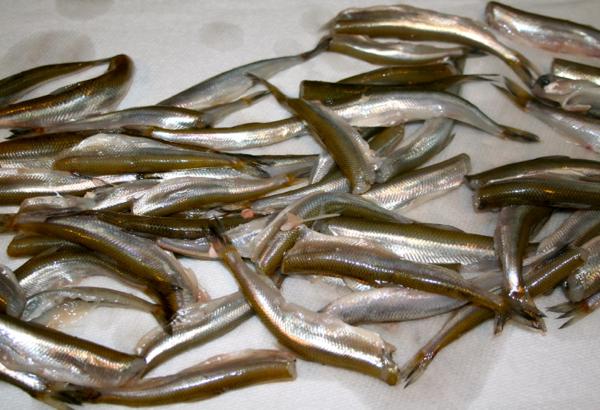As a hunter and fisherman, I understand that not every day is going to be a success in terms of putting meat on the table. I spend way more time in the field pursuing game and fish than I do catching or killing something. That said, I do have successful days and almost always bag my intended quarry, eventually. This is not the case with smelt; nothing has eluded me more than these tiny little fish. On my most successful smelt fishing excursion, I only managed to catch fourteen smelt. Fourteen, which is barely enough for an appetizer, and there were four of us out netting that night.
I first heard of smelt about 15 years ago from Rick Edwards, a good friend and longtime fishing and hunting partner. He had wanted to go up to the North Shore of Lake Superior and try to catch the fish. Rick had heard stories of people catching smelt in the early spring and catching so many that they would fill the back of a pickup truck full of these small cigar-sized fish. It sounded like a good time, so I agreed to go and the first ever Edwards Smeltfest was born. Our first year up was less than successful and not a single smelt was caught. We tried this for several years, unsuccessfully, and had come to the conclusion that the stories of people catching boatloads of smelt were just stories.
It took us a while to figure out that you can’t go fishing for smelt when you think they are going to be there. You have to go when they are there, which is difficult because their spawning time ranges from early April to mid-May. Water temperatures have to be just right or the moon has to be in the right phase or some other unknown trait has to be perfect. In order to get smelt you have to be there at the exact right time. This makes it very difficult if you don’t live in an area where smelt run. This year, a couple buddies of mine had read online that the smelt were starting and they took off that minute to go up and managed to hit it just right. They filled a couple of five-gallon pails with smelt, which is a pretty good haul. The very next night, Rick headed up to the same spot and only managed to catch 24 smelt.
Smelt are only about five to six inches long and you don’t fish for them like you would other fish. In order to catch smelt, it requires getting into the water with a dip net or a seine net and actually netting them. They also don’t start running until late at night, so imagine being out in the middle of the night in freezing cold water trying to net something that may or may not be there. Some people might question if it is actually worth it. I was one of those people, and after years of not getting anything, I had pretty much given up on trying to catch smelt. I had eaten smelt a few times and they weren’t bad but they weren’t so good that I had to have more of them.

Smelt are usually fried, and the few times I have had them they have been overbreaded or battered to a point where you couldn’t even taste the fish. When I decided to cook the ones I got from my friends, I wanted to make sure that didn’t happen. The first batch of smelt I cooked I used a recipe from one of my Greek cookbooks. It called for a little bit of lemon and olive oil, then a light dusting of seasoned flour and then into the fryer. That first batch was amazing and I served them on a bed of arugula with garlic and lemon vinaigrette.
Frying the smelt softened the bones enough that you couldn’t even notice them. They were light and crisp and you could taste the sweetness of the smelt. After my first batch, I am now hooked on smelt. I am very lucky that I was given two gallon bags full of smelt; I am also looking forward to next year already and have a new interest in going smelting.
For my second batch of smelt, I wanted to do something with tartar sauce so I opted to make a beer batter. I had a very productive spring and was able to gather about five pounds of ramps. I picked three quarts of ramps and have been itching for a reason to try a pickled ramp tartar sauce. Beer batter can be a little heavy, so I wanted to make sure to thin out my batter so it only lightly coated the smelt. I added about half a cup of water to my beer batter to thin it out to the consistency of heavy cream. This coated the smelt but didn’t overwhelm them.

Beer Battered Smelt
1 pound fresh cleaned smelt
2/3 cup flour
1 tablespoon Cavender’s Greek seasoning
1 cup of your favorite beer
I also like to add a couple dashes of cayenne pepper to give it a little warmth.
Make sure your smelt are dry and then dip them into the batter and shake off the excess. Fry in oil for 2 to 3 minutes until golden brown. You don’t want to over fry these little guys or they will turn into an odd textured fish jerky.
Pickled Ramp Tartar sauce
1/2 cup mayo
1/4 cup pickled ramps chopped fine
2 tablespoons sweet relish
1/4 teaspoon chipotle powder
Mix all ingredients and let sit in the fridge for at least a half hour before serving.
These recipes would work with other types of fish, but hopefully you'll have some smelt to try them out!
 Jamie Carlson lives in Burnsville with his wife, Amanda, and their two kids, Eleanor and Charlie. He works as an RN at the Minneapolis VA hospital and enjoys hunting, fishing, foraging, and of course, cooking. He believes that all food can be tasty if it's prepared with care, and he writes about his adventures cooking everything from pickled venison heart to roasted dove on his food blog, You Have to Cook it Right. Follow him on Twitter at @youcookitright.
Jamie Carlson lives in Burnsville with his wife, Amanda, and their two kids, Eleanor and Charlie. He works as an RN at the Minneapolis VA hospital and enjoys hunting, fishing, foraging, and of course, cooking. He believes that all food can be tasty if it's prepared with care, and he writes about his adventures cooking everything from pickled venison heart to roasted dove on his food blog, You Have to Cook it Right. Follow him on Twitter at @youcookitright.

